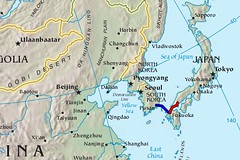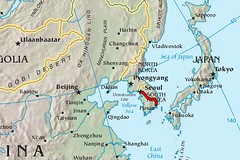Bullet train to Hiroshima
The sailing on the jet hydrofoil from Busan to Hakata was boring. You are never aware of the boat rising up onto the wing things, and if the GPS hadn't told us we were travelling at 75kph (47mph) we would never have known. The only thing which made the journey more interesting was the threat of colliding with a whale at any moment. Seriously, the ferry company warned all passengers to remain in their seats with seat belts fastened in case we had to make an emergency stop to avoid a whale (see picture). Hitting a whale at the speed we were going wouldn't have been pleasant.
About half way into the three-hour journey we passed quite close to the Japanese island of Tsushima. At the same time the clouds dispersed and the sun came out, and Japan looked lush and green.
We docked in Hakata (a.k.a. Fukuoka) at 14:05, where the immigration guy took a long hard look at our passports. He seemed interested that we had visited the same city briefly exactly a year ago. We could see what he was wondering... illegal work? It was made worse by the fact that in the "address in Japan" section of the arrivals card we had nonchalantly written "travelling". He quizzed us in great detail on our itinerary in Japan, so we told him honestly that we didn't have a fixed plan, and then gave him a list of cities that we would probably be visiting. For the first time in our trip we were asked to produce return tickets to prove that we were planning to leave. We didn't have any. For a brief moment it didn't look good, but then he just smiled and said "Have a nice stay". We were in, and we had no problems passing through customs.
Now we were in Japan but we still had no accommodation and no idea where we were going next. But we did have a Japan Rail Pass exchange voucher, which we had bought from a travel agent in Seoul (you can't buy it in Japan) for 275,600 Won (114.93 GBP / 224.65 USD). This little piece of paper, when swapped for an actual pass, would give us seven days of unlimited train travel on the JR network anywhere in Japan. Considering the price is only slightly more than a single one-way journey from Hakata to Tokyo, it's a screaming bargain. So, our rough plan was to get on the first available train to Hiroshima, but as we didn't know how full the trains were going to be, Plan B was to take another train somewhere else. Plan C (there's always a Plan C, right?) was to stay the night in Hakata and try again tomorrow.
Hakata felt a little familiar to us, since we spent two days here last year collecting our Korean work visas. We were planning to walk from the ferry terminal to the station, but it was hot and we had our luggage so we caught a bus from just outside the ferry terminal. Taxis in Japan are a definite no-no if you're watching your budget, and we're still thinking in Korean prices! At the station as we followed signs for the Japan Rail Pass desk, we remembered the eventful day in India last year when we went to New Delhi station. That time it took us four hours of scam dodging, crowd avoiding, queuing and mind-numbing form filling to buy a few tickets. We were braced for a marathon.
The desk was pretty easy to find, and the lady there spoke good English. We handed her the exchange forms, and our passports to show that we were in Japan as temporary visitors. Then she asked us when we'd like the seven day period to start, and we said that, if it was possible, we'd like to go to Hiroshima today. Without checking anything, she said that was no problem. How could she be sure? Had she misunderstood? We were just about to ask whether she thought it would be a good idea to make a seat reservation, or whether there would be spaces in the unreserved section, when two tickets popped out of the printer under the counter. She handed them to us, along with our shiny new passes (which look a lot like Christmas cards). We were in reserved seats on the bullet train to Hiroshima leaving in six minutes!
Nine minutes after asking if it would be possible to get on a train today, we were outside the city limits travelling at 250 km/h and accelerating.
Oh... My... God... Japan makes our country's arcane rail system look like India's.
Seventy silent, gliding minutes later we arrived no seconds late at Hiroshima station. We decided to give the Tourist Information desk at the station a go, to see if they could come up with some reasonably-priced accommodation. They could, and a woman with excellent English booked us a semi-double (semi-double? Sounds tiny) at the Comfort Hotel Hiroshima for 6,200 yen (GBP 29.94 / USD 58.52) per room per night including breakfast and free internet. A price like that was most definitely not in the script! We were expecting to have to choose between staying in a flea-pit or completely emptying our wallets.
After a tasty tonkatsu lunch in one of the many restaurants in the station we caught a tram to our hotel and checked in. The room is indeed tiny, but it is spotlessly clean, has a bathroom, window, fridge, a TV with at least one English channel, and free wireless internet. It's perfect. So far, so good. It's starting to sink in that we're back travelling. But what sort of reception are we going to get in the world's first nuked city?
Day 559
Busan to Hiroshima
This map shows the route we took in this post. Click it to see larger maps of our whole route at flickr.
Maps are taken from the CIA World Factbook.


![[IMG_4050]](http://farm4.static.flickr.com/3064/2553475380_6f6d311014_m.jpg)
![[IMG_4059]](http://farm4.static.flickr.com/3121/2552664777_b7a8387b1c_m.jpg)

![[IMG_4041]](http://farm4.static.flickr.com/3051/2552633885_9f96b798ba_m.jpg)
![[IMG_4047]](http://farm4.static.flickr.com/3055/2553459642_0d0f8084e9_m.jpg)

![[IMG_3864]](http://farm4.static.flickr.com/3290/2507327649_38ca92f034_m.jpg)
![[IMG_3852]](http://farm4.static.flickr.com/3085/2507313237_0cbbb9cf75_m.jpg)
![Incheon fish market. [IMG_3628]](http://farm4.static.flickr.com/3125/2486133058_b429a35be2_m.jpg)
![[IMG_3878]](http://farm3.static.flickr.com/2215/2507345485_ffa8c921c9_m.jpg)
![[IMG_3953]](http://farm4.static.flickr.com/3269/2537440973_dee9f1de26_m.jpg)
![Tangsuyuk and jajjangmyeon seteu. [IMG_3954]](http://farm3.static.flickr.com/2067/2537440981_d45a80b3c6_m.jpg)
![[IMG_3847]](http://farm3.static.flickr.com/2110/2494439372_d668551bc7_m.jpg)
![[IMG_3979]](http://farm3.static.flickr.com/2109/2538282666_c4690d2cf3_m.jpg)
![War Memorial of Korea. [IMG_3606]](http://farm4.static.flickr.com/3063/2485306219_0aa3e10767_m.jpg)


